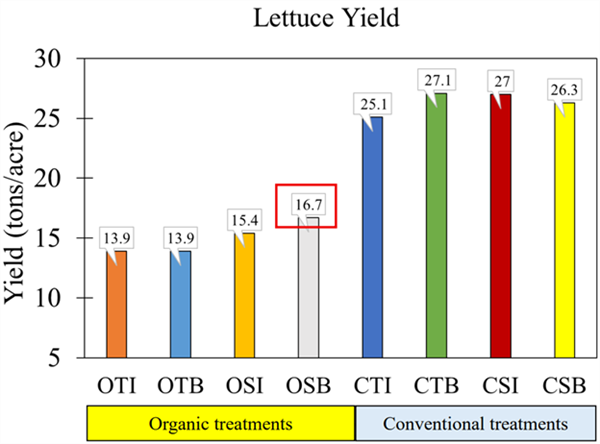Improving crop yields through sustainable practices remains a key goal for agricultural research, particularly in regions facing environmental constraints like desert conditions. Biostimulants, products known to enhance plant growth, nutrient uptake, and resilience against environmental stress, offer potential benefits for organic agriculture, especially when integrated with precision irrigation techniques. This study, conducted at the Yuma Agricultural Center (University of Arizona) during the Fall 2024–Spring 2025 growing seasons, evaluated the effects of biostimulant combined with sensor-based irrigation scheduling on iceberg lettuce production under organic and conventional systems. The experimental design included four treatments each for organic and conventional systems, which combined traditional irrigation, sensor-based irrigation, and biostimulant applications.
Results indicated clear distinctions between organic and conventional lettuce systems in response to biostimulant treatments. In organic fields, the integration of biostimulant with sensor-based irrigation (OSB) achieved the highest yield, approximately 16.7 tons per acre. This represented a 20% improvement over organic treatments without sensor-based scheduling (OTI and OTB, 13.9 tons per acre) and an 8.4% increase over sensor-based irrigation without biostimulant (OSI, 15.4 tons per acre). These yield differences highlight the synergistic effect of combining biostimulant with precise irrigation water management techniques in an organic lettuce production system, potentially due to enhanced soil nutrient availability, improved root growth, and optimized water uptake. Conversely, conventional treatments yielded consistently high production across all variations, averaging around 27 tons per acre, with no measurable yield enhancement from adding biostimulant. This may indicate that conventional systems already operating at optimal nutrient and irrigation levels have limited potential for further yield improvement through biostimulant use.
These findings emphasize that biostimulant suggestively enhanced yield in organic lettuce production only when combined with sensor-based irrigation management but offered negligible benefits under conventional farming conditions. The outcomes suggest potential economic and environmental benefits for organic producers adopting integrated management practices involving biostimulant and sensor-based irrigation. Figure 1 provides detailed comparisons of yields across treatments, emphasizing the advantage of coupling biostimulant with sensor-based irrigation in organic systems at the Yuma Agricultural Center.

Figure 1. Lettuce yield: Organic Field: Organic sensor-based irrigation + biostimulant
(OSB), Organic traditional-based irrigation (OTI), Organic traditional-based irrigation +
biostimulant (OTB), and Organic sensor-based irrigation (OSI); Conventional Field:
Conventional sensor based irrigation + biostimulant (CSB), Conventional traditional-based
irrigation (CTI), Conventional traditional-based irrigation + biostimulant (CTB), and
Conventional sensor-based irrigation (CSI) at the Valley Research Center, University of
Arizona, Yuma Agricultural Center, Yuma, Arizona.






